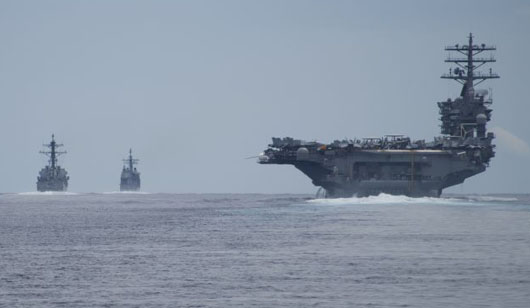by WorldTribune Staff, July 12, 2017
The U.S., Japanese and Indian navies have each dispatched aircraft carriers to the Bay of Bengal to take part in an exercise which analysts say is aimed at checking China’s increased presence in the region.
The USS Nimitz of the U.S. Navy, INS Vikramaditya of the Indian Navy and the JS Izumo of the Japan Maritime Self-Defense Force are taking part in the 21st edition of the Malabar exercise from July 10-17.

Gurpreet Khurana, Indian Navy captain and executive director of the National Maritime Foundation, said, “Malabar is essentially a combined endeavor between India and the U.S. — now expanded to Japan — to translate their national-strategic convergences in the Indo-Pacific region into functional maritime-military collaboration.”
According to Indian media, Chinese submarines were spotted this month in the Indian Ocean.
In 2014, a Chinese submarine made a port call in Sri Lanka, and one the following year in Pakistan, demonstrating China’s efforts to strengthen relations with coastal nations in the region, Japan’s Asahi Shimbun reported.
Officials said the focus of the joint maneuvers is on aircraft carrier operations, air defense, anti-submarine warfare, visit board search and seizure and search and rescue.
Without naming any country, Rear Adm. William Byrne, commander of U.S. Strike Group 11, told reporters that the only strategic message Malabar 2017 is sending is to “eliminate possibilities of miscalculations” and that “we are together.”
Japan has sent 700 Maritime Self-Defense Forces (MSDF) to Malabar 2017, which represents its largest contingent yet to a joint naval exercise.
“Maintaining the stability of the Indian and Pacific oceans is an important national interest of the three nations,” said Hiroshi Yamamura, vice chief of staff of the Maritime Self-Defense Force.
“Our involvement is aimed at deepening the relationship between the three nations.”
The Izumo, the MSDF’s largest vessel, is able to handle nine helicopters simultaneously to maintain surveillance over submarines.
A high-ranking Defense Ministry official said, “The Izumo was the most appropriate vessel to demonstrate Japan’s seriousness about the exercise.”
Japanese Prime Minister Shinzo Abe touched upon the Malabar exercise during talks July 7 on the sidelines of the G20 summit in Germany with Indian Prime Minister Narendra Modi, calling it “a symbol of defense cooperation between Japan and India.”
Letters to the Editor __ Subscribe to Geostrategy-Direct __ Support Free Press Foundation
